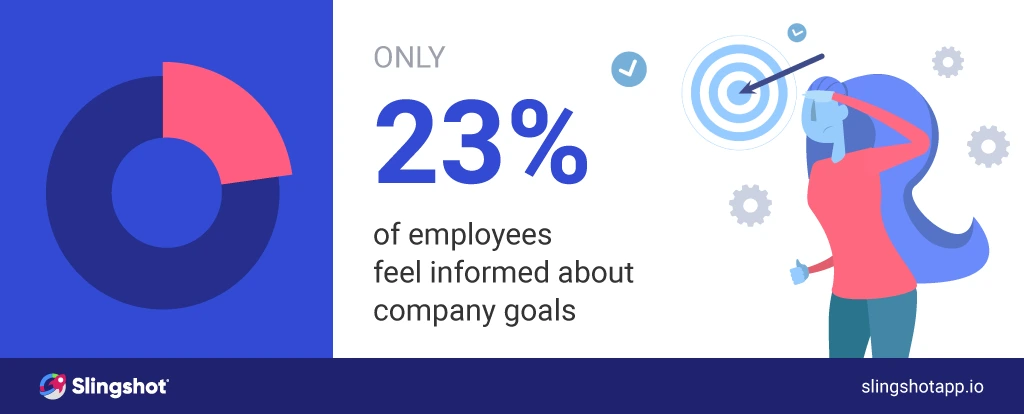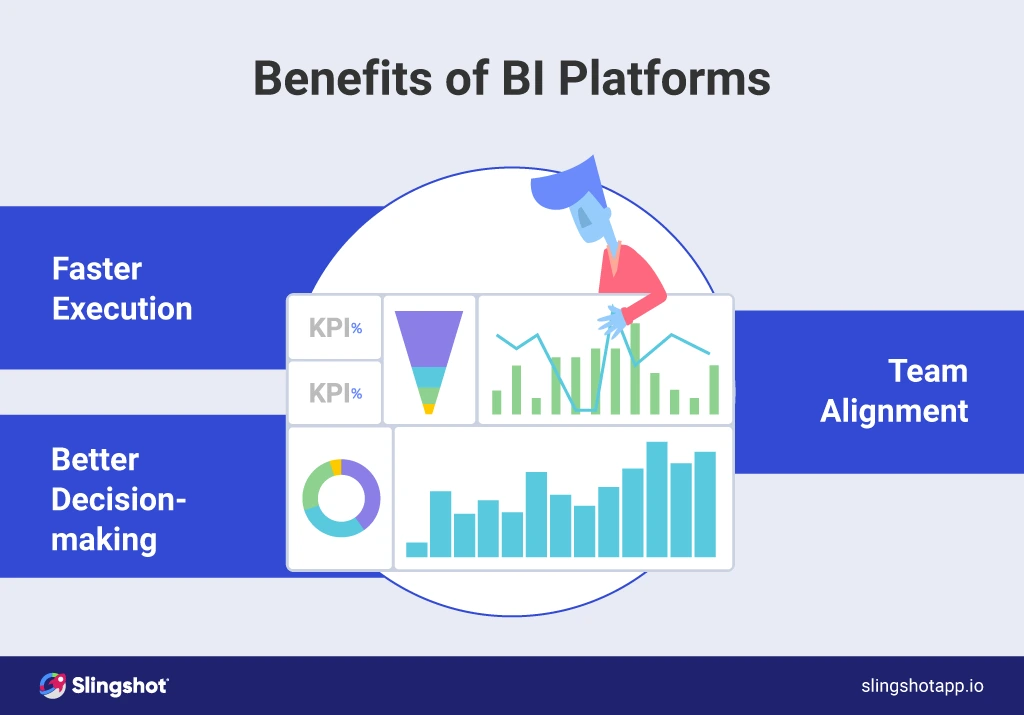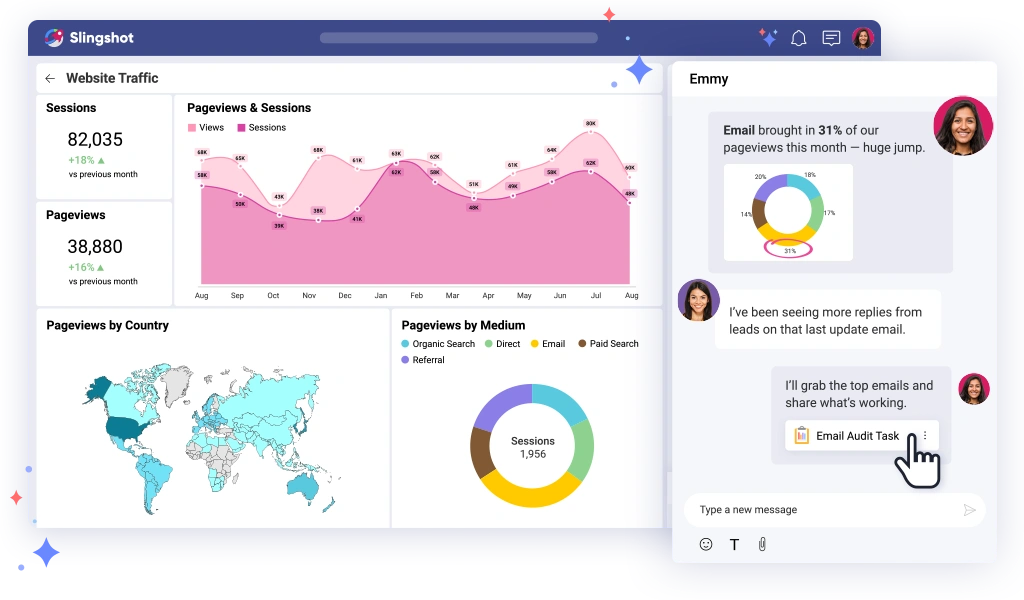
A Beginner’s Guide to BI Software: Features, Benefits & Use Cases
BI platforms are only useful if they help your team act, not just analyze. Traditional tools focus on dashboards and reporting, but modern organizations need real-time visibility, accessible insight, and immediate alignment across teams. The most effective BI tools now live inside the work, not alongside it. They eliminate delays, reduce manual effort, and surface what matters while there’s still time to respond. The difference is not just in features. It’s in outcomes that impact daily execution and long-term growth.
Executive Summary:
BI platforms are only useful if they help your team act, not just analyze. Traditional tools focus on dashboards and reporting, but modern organizations need real-time visibility, accessible insight, and immediate alignment across teams. The most effective BI tools now live inside the work, not alongside it. They eliminate delays, reduce manual effort, and surface what matters while there’s still time to respond. The difference is not just in features. It’s in outcomes that impact daily execution and long-term growth.
Key Takeaways:
- BI must support action, not just visibility
- Static reports and dashboards are no longer enough
- Real-time, in-workflow insight speeds up decision-making
- Modern BI reduces dependency on analysts and manual exports
- Alignment and execution improve when data meets context
- The cost of outdated BI is lost time, missed signals, and slower growth
You don’t win by knowing what happened last week. You win by responding faster than your competitors.
That’s the shift. Business intelligence is no longer about static reports and lagging dashboards. It’s about turning data into action. Fast. In real time. Inside the tools where work already happens.
Three forces are driving this change:
- AI is reshaping how decisions are made
- Operational data now needs to be updated continuously, not in batch reports
- Teams expect insights to live inside their workflow tools, not in separate platforms

When insight lives outside of execution, teams fall out of sync. In Slingshot’s 2024 Digital Work Trends Report, only 23% of employees said they feel informed about company goals, while 84% of leaders believe they communicate them clearly. That’s not just a miscommunication issue. It’s a visibility failure.
Business intelligence features that aren’t built for speed, context, and alignment will continue to miss the mark. If your BI tool can’t close that gap, it’s not driving the outcomes you need.
What Modern BI Must Deliver
The problem isn’t that your BI tool doesn’t work, it is that it solves the wrong problem.
Most platforms still operate like rearview mirrors. Insight arrives too late, buried in dashboards no one checks or tied to monthly reporting cycles. By the time a trend is spotted, the opportunity to respond is gone.
Modern business intelligence features must close the gap between knowing and doing. You need data that surfaces in real time, not after the fact. You need insight that appears where the work happens, not in a separate tab or delayed export.
Here’s what modern BI must deliver:
- Faster decisions with less friction
- Clear alignment across teams and goals
- Instant access for non-technical users
- Actionable insight triggered by what’s happening now
A spike in support tickets should trigger a reallocation. A stalled deal should prompt a follow-up before it drops out. A failing campaign should be flagged while there’s still time to shift the budget. These are the moments where bi benefits become business outcomes.

This is not about tracking performance. It’s about powering it. The best BI software features now include AI-generated recommendations, proactive alerts, and contextual analytics that sit inside your workflows.
If your BI is still built for visibility, you’re making decisions too late. If your teams aren’t aligning on the same numbers in real time, you’re losing clarity and wasting time.
The shift is no longer optional. The tools must move as fast as your business does.
What Decision-Makers Should Demand from BI Tools Today
The value of a BI tool isn’t measured by how many reports it creates. It’s measured by how quickly your teams can turn insight into action.
The value of a BI tool isn’t measured by how many reports it creates. It’s measured by how quickly your teams can turn insight into action.
Dashboards and exports are expected. The business intelligence features that matter now are the ones that deliver clarity in the moment and show up where work is happening.
Your BI platform should provide:
- Answers without analysts. If a team lead can’t ask a question in plain language and get a clear answer, the platform creates a delay.
- Insights inside workflows. Data shouldn’t require a separate login. BI must appear in the tools your teams already use.
- Proactive alerts and recommendations. A strong platform surfaces problems before they become risks.
- Real-time visibility across systems. Decisions based on stale or incomplete data slow everything down.
- AI that guides action. Predictive context gives your team direction, not just reports.
- Simple scale. Whether your team is 20 people or 2,000, speed and access should never become bottlenecks.

These are not technical preferences. They are functional requirements for clarity, execution, and pace. The BI benefits you expect, like faster execution, team alignment, and better decision-making, depend on them.
If your platform lacks these BI software features, you’re losing time and missing signals that should have been caught earlier. You’re reacting when you could be leading.
For companies still using outdated BI, it often feels like things are fine, right until the cracks show. That’s when the real cost of inaction becomes obvious.
The Risk of Doing Nothing
It’s easy to stick with the BI tool you already have. The reports are familiar. The dashboards load. The team knows its way around.
But that familiarity comes at a cost.
Outdated BI platforms slow your team down in subtle ways. Data lives in one system while work happens in another. Simple questions require manual exports. Visibility fades the moment something changes.
What starts as convenience becomes a drag on the business. Delayed decisions. Missed signals. A strategy that reacts too late.
You’ve likely seen the symptoms: teams operating from different reports, analysts fielding repeat questions, insights stuck in outdated dashboards; decisions delayed until the monthly sync. These aren’t edge cases. They are daily slowdowns.
And the consequences aren’t small. When your BI tools’ features can’t deliver clarity in real time, execution loses momentum. When alignment fades, progress stalls. That’s when the BI benefits you paid for quietly disappear.
A BI tool that can’t keep pace with your team isn’t just inefficient. It’s a barrier to growth.
Modern BI eliminates those barriers. And the difference becomes clear when you see how it works in practice.
What Modern BI Looks Like in Practice
Modern BI doesn’t live in spreadsheets or static dashboards. It lives inside the work. It moves with the business. And it empowers teams to respond in real time, not in hindsight.
These examples show how today’s BI tools enable fast cross-functional decision-making. They deliver embedded, actionable insight as part of the workflow, not after the fact.
1. Marketing: See what’s underperforming and fix it immediately

A campaign’s return drops below the target mid-week. Instead of waiting for a performance review, the team gets an alert directly inside their workspace. By the end of the day, the budget is reallocated, and the underperforming asset is replaced.
This is BI that shows up where the work happens. No meetings. No digging. Just fast, informed action.
2. Sales: Spot pipeline risk before it turns into missed revenue
A high-value deal slows down. The system notices, flags it, and prompts the rep to follow up. The sales lead doesn’t have to request a pipeline review or wait for a dashboard update.
When BI can detect behavioral signals and prompt action, reps stay focused on what is moving instead of what is just visible.
3. Finance: Adjust forecasts in real time
Supplier costs spike unexpectedly. The forecasting model updates automatically, and finance leadership sees the change right away. No waiting for a month-end close. No lag between cost and course correction.
This is where business intelligence features create real impact. Leaders don’t just review performance. They respond to it at the moment it changes.
4. Operations: Respond to shifts in workload instantly
Support ticket volume surges. Instead of burning out the team or creating a backlog, the system triggers a workload alert and reroutes tasks to underused staff.
When BI is embedded in operations, problems are handled as they appear. Not after they escalate.
5. Leadership: Align departments around shared KPIs
Executives track KPIs across departments through a single view built directly into the team’s collaboration hub. When a number shifts, everyone sees it and adjusts together.
This is the kind of alignment that legacy BI rarely delivered. Modern BI makes it standard.
At Major League Baseball’s Scouting Bureau, the team uses Slingshot to give non-technical users access to real-time data throughout scouting and tournament cycles. Instead of relying on analysts or waiting for reports, staff across the organization access and act on data themselves. That level of autonomy turns analytics into execution.
These BI use cases show how data becomes a strategic asset. Not just when visualized, but when used.
How Slingshot Builds for the Modern BI Era
Slingshot isn’t just another BI tool. It’s built to solve the problems that slow teams down — decision delays, data silos, and insight that’s disconnected from the work.

Every feature is designed to help your team make better decisions, faster, without switching tools or chasing down reports.
Here’s what that looks like in action:
- Ask your data anything. Get instant answers.
Natural language querying makes insight accessible to everyone, not just analysts. - Dashboards that update in real time, inside your workspace.
No more waiting for static reports. Teams see what’s changing as it happens. - Insights appear where the work is.
Data is embedded inside projects, tasks, and discussions. No more jumping between tools. - No analyst required.
Self-service analytics lets anyone explore data and make informed decisions, even without a technical background. - Templates by role and function.
Start fast with purpose-built dashboards for marketing, sales, ops, and leadership. - Mobile and cloud-native.
Teams can access insight from anywhere, whether in the office or on the move. - AI-enhanced recommendations.
Slingshot surfaces risks and opportunities before they turn into missed revenue or operational waste.
These aren’t just BI software features. They are the reason teams using Slingshot make faster, more aligned, and more confident decisions.
The BI benefits you expect from a modern platform are built in. And the business intelligence features that matter most are already connected to the way your team works.
Related Articles
Ready to grow your business 10x with AI decision-making?
Request a Free Demo of SlingshotSHARE THIS POST




 Return to Blog
Return to Blog



